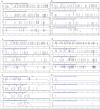Profiling of Antifungal Activities and In Silico Studies of Natural Polyphenols from Some Plants
- PMID: 34885744
- PMCID: PMC8659076
- DOI: 10.3390/molecules26237164
Profiling of Antifungal Activities and In Silico Studies of Natural Polyphenols from Some Plants
Abstract
A worldwide increase in the incidence of fungal infections, emergence of new fungal strains, and antifungal resistance to commercially available antibiotics indicate the need to investigate new treatment options for fungal diseases. Therefore, the interest in exploring the antifungal activity of medicinal plants has now been increased to discover phyto-therapeutics in replacement to conventional antifungal drugs. The study was conducted to explore and identify the mechanism of action of antifungal agents of edible plants, including Cinnamomum zeylanicum, Cinnamomum tamala, Amomum subulatum, Trigonella foenumgraecum, Mentha piperita, Coriandrum sativum, Lactuca sativa, and Brassica oleraceae var. italica. The antifungal potential was assessed via the disc diffusion method and, subsequently, the extracts were assessed for phytochemicals and total antioxidant activity. Potent polyphenols were detected using high-performance liquid chromatography (HPLC) and antifungal mechanism of action was evaluated in silico. Cinnamomum zeylanicum exhibited antifungal activity against all the tested strains while all plant extracts showed antifungal activity against Fusarium solani. Rutin, kaempferol, and quercetin were identified as common polyphenols. In silico studies showed that rutin displayed the greatest affinity with binding pocket of fungal 14-alpha demethylase and nucleoside diphosphokinase with the binding affinity (Kd, -9.4 and -8.9, respectively), as compared to terbinafine. Results indicated that Cinnamomum zeylanicum and Cinnamomum tamala exert their antifungal effect possibly due to kaempferol and rutin, respectively, or possibly by inhibition of nucleoside diphosphokinase (NDK) and 14-alpha demethylase (CYP51), while Amomum subulatum and Trigonella foenum graecum might exhibit antifungal potential due to quercetin. Overall, the study demonstrates that plant-derived products have a high potential to control fungal infections.
Keywords: antifungal; antioxidant activities; edible plants; molecular docking; polyphenols.
Conflict of interest statement
The authors declare no conflict of interest.
Figures


References
MeSH terms
Substances
Grants and funding
LinkOut - more resources
Full Text Sources
Medical

